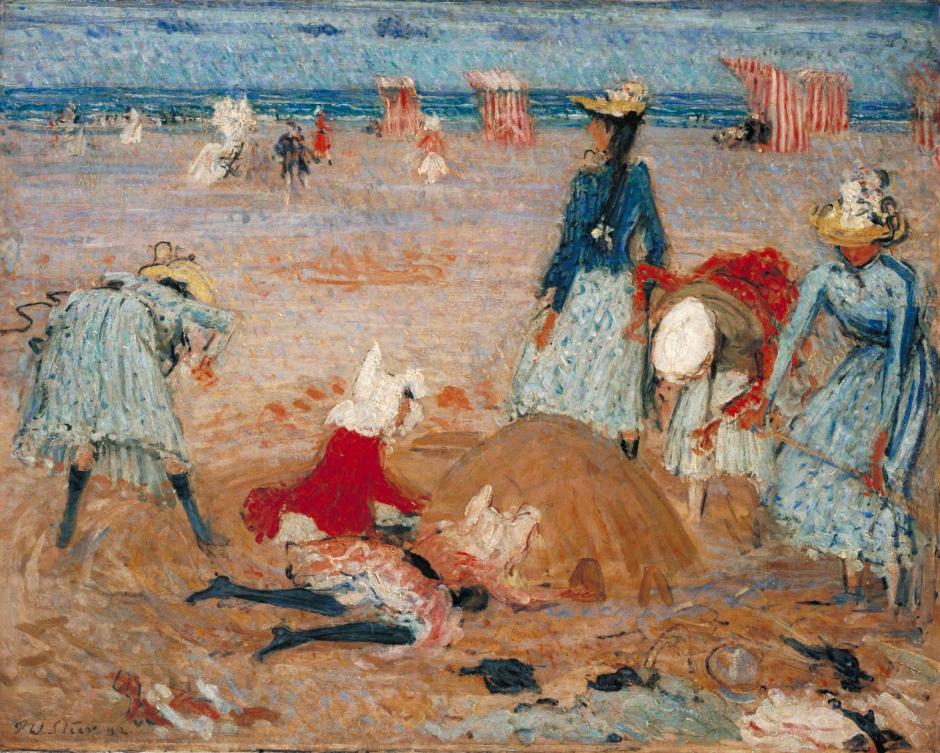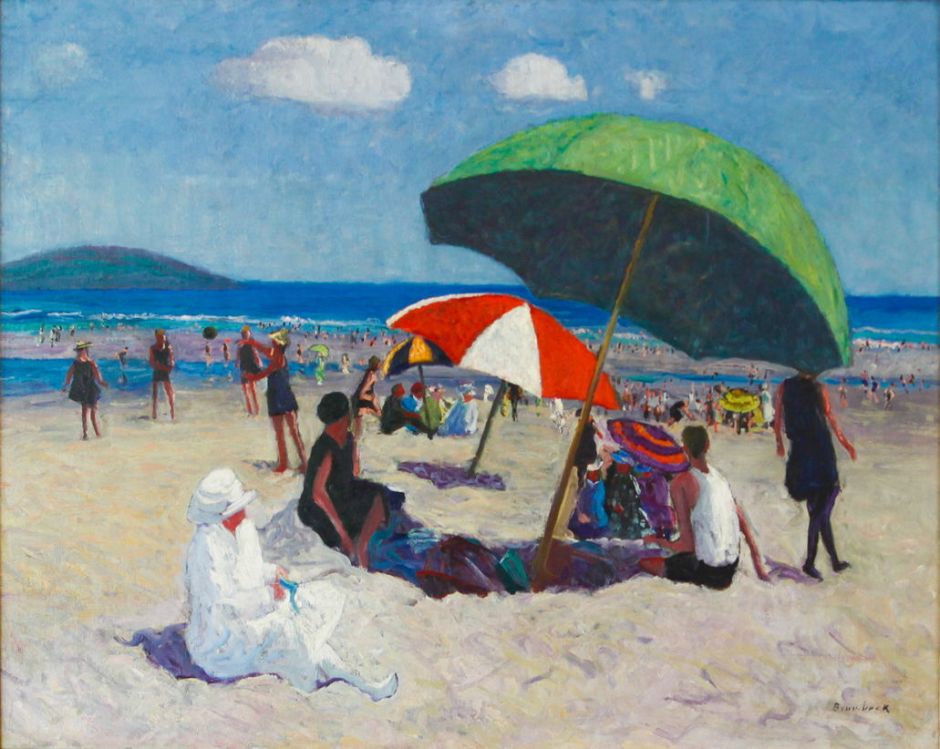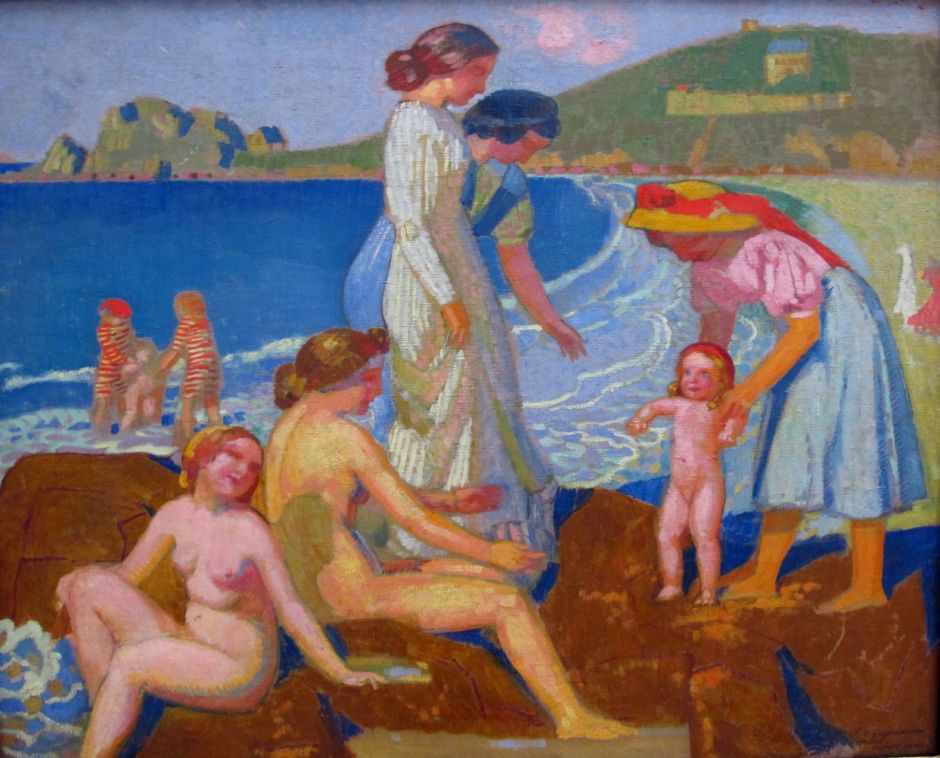In the first of these two articles in which I take to the beach, I showed a selection of paintings of beachgoers enjoying sitting, lying and swimming from 1788 to the 1880s. Today’s sequel concludes with views up to 1922.

Charles Conder’s Holiday at Mentone (1888) is probably his most famous painting, and one of the earliest showing Australians enjoying the beach. This has some distinctly unusual details: its elevated walkway has been claimed to add a Japanese air to an otherwise very Australian scene. A lone parasol rests on the sand in the left of the painting, although it doesn’t appear to have been missed by any of the people around.
Figures in the foreground are curiously dissociated from one another, and from the scene itself: a woman sits in a chair, reading; a man wearing a tall black hat (contrasting with his white suit) stares intently towards the right of the picture, at an unseen object; another man is sprawled asleep, his left arm reaching up at nothing. There appears to be an unresolved narrative, something which others have noted gives the painting a surreal tone.

If you’ve been following my series on British Impressionists, you’ll be familiar with the paintings of beach scenes by Philip Wilson Steer. This is one of Boulogne Sands (1888-91) on the north coast of France.

Charles Conder left Australia in 1890 for Europe. After a turbulent time in France, he came to Britain in the mid 1890s, and visited Cornwall. Although he appeared sickly and engaged in bouts of heavy drinking, his painting seemed to thrive, and some of his works from these years are among his best. This oil painting of The Sands, Newquay from about 1900 shows this beach which is now very popular with surfers, and has long been famous for its sands.

Lovis Corinth had to settle for the more bracing waters of the Baltic when he painted Swimming in Horst – Ostsee in 1902. Paradoxically, in this cooler location, most of the beachgoers and bathers have discarded the heavy and modest clothing seen in previous views, in favour of skimpy trunks.

In the summer of 1905 and the following year, Frederick Carl Frieseke visited Giverny, where an art colony had formed around Monet’s house and garden. Although he was now so close to Monet, his paintings showed little influence from Impressionism, as in his Afternoon at the Beach (1905-6).

At this time, several artists who had painted in northern Europe fled cold winters and sought solace in the Midi, the south coast of France. Théo van Rysselberghe painted several motifs in which bathers are seen under the pines just inland of the beach, including Bathers under the Pines at Cavalière (1905).

Paul César Helleu’s On the Beach (1908) is an impressive panoramic view which may have been influenced by the many panoramas which were being shown to the public across Europe. Helleu was a close friend of John Singer Sargent.

Among the many paintings of the beaches of Joaquín Sorolla’s native Valencia in Spain, a few show beachgoers at leisure. Among them is After the Bath (1908).

Between 1908 and 1912, William Orpen spent his summers on the coast to the north of Dublin, Ireland, at the resort of Howth. In 1910, he painted Midday on the Beach which captures the pre-war day out: lightweight clothing, parasols, and a large wicker hamper containing a packed lunch.

On the other side of the Atlantic, Louise Upton Brumback was painting much more modern scenes and dress on the New England coast near Gloucester, Massachusetts. Bathers Along the Shore, from 1910, (above) and Good Harbor Beach (1915) (below) show her vibrant colour.


When the former Nabi artist Maurice Denis spent the summer of 1912 in Brittany, he painted an unusual work there, Female Bathers at Perros-Guirec. Unlike Pierre Bonnard, Denis painted very few nudes, and those shown here not only reflect changing social standards, but his changing art.

Beaches are also one of the sites in which some of our cultural heritage is preserved – performance arts which go back to mediaeval roots, and live on in slapstick puppet theatre for children. Visitors to the Hunter Museum of American Art, in Chattanooga, Tennessee, must find William S Horton’s painting of Punch on the Beach at Broadstairs, England (1920) quite cryptic. Horton was born in Grand Rapids, Michigan, and trained in Chicago, Paris, and New York, then painted almost entirely in Europe.
In about 1917, he arrived in Britain, and in 1920 painted this Punch and Judy show taking place on the beach at Broadstairs, Kent – a traditional family beach resort at the extreme eastern tip of the south-east coast of England.
Punch and Judy shows have their origin in the sixteenth century Italian commedia dell’arte, with the lead male character, Mr Punch, based on Pulcinella, a trickster figure who batters his wife, Judy. The first recorded show in Britain was on 9 May 1662, using marionette puppets. For the last two hundred years or so, a stylised version performed using glove or other puppets has been popular with children visiting British resorts, and later beach resorts. In 1827, George Cruikshank made a series of sketches of a performance, which were turned into the first illustrated and printed script.

My final painting, which dates from about 1922, shows the beach in south-west France, in the southern part of the Bay of Biscay. Pierre Bonnard’s The Beach (Arcachon) (c 1922) is packed, with tents and awnings covering the golden sand, crowds of people and moored yachts in the distance. Beyond them is a vague line of breakers, where the bed of the Atlantic Ocean rises to form the shallows of the coast of France.
Don’t get burnt by the sun!

